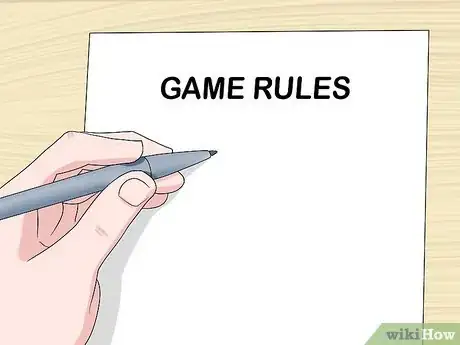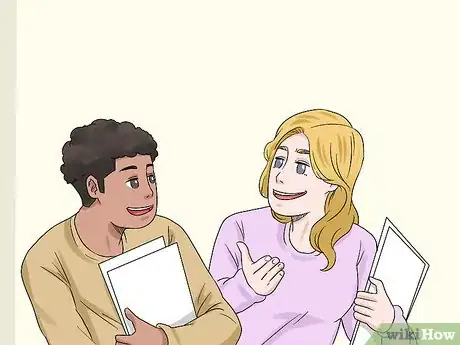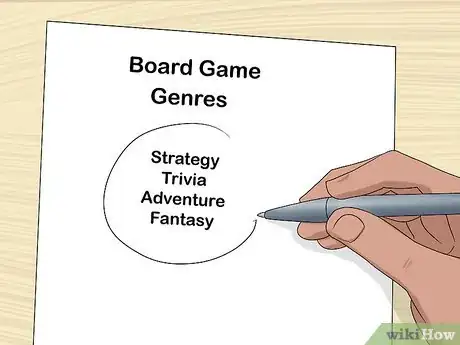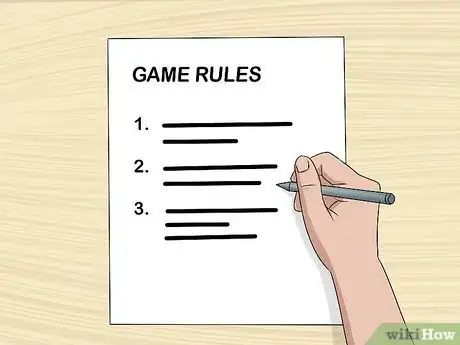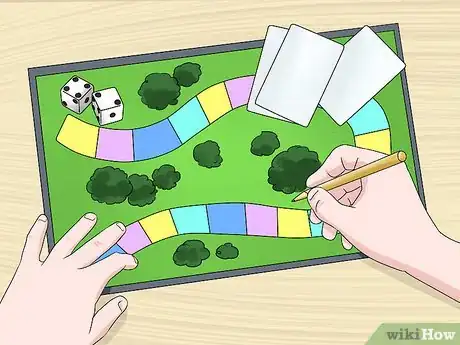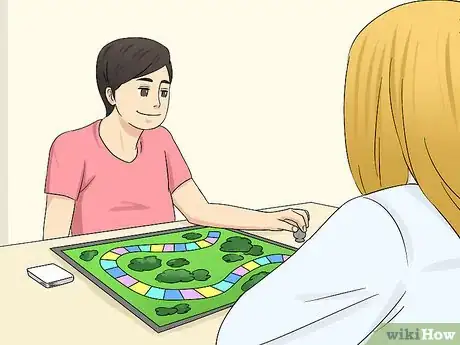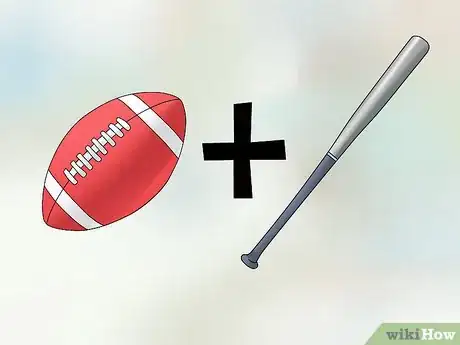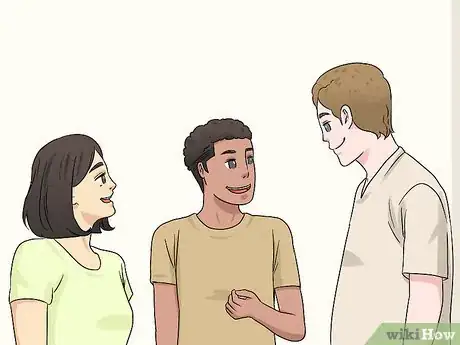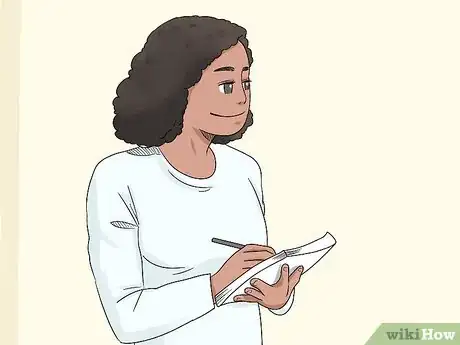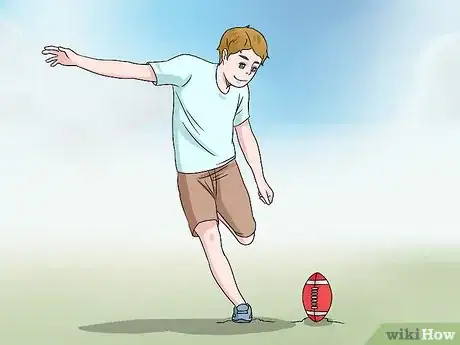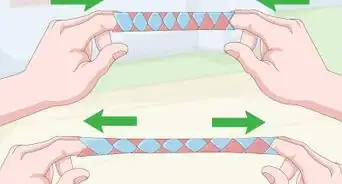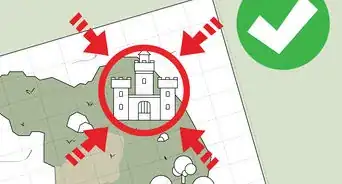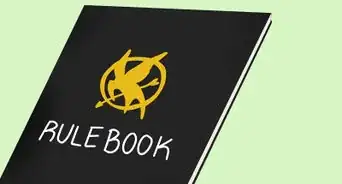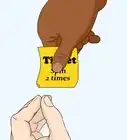This article was co-authored by wikiHow Staff. Our trained team of editors and researchers validate articles for accuracy and comprehensiveness. wikiHow's Content Management Team carefully monitors the work from our editorial staff to ensure that each article is backed by trusted research and meets our high quality standards.
There are 7 references cited in this article, which can be found at the bottom of the page.
This article has been viewed 55,027 times.
Learn more...
Whether you're feeling creative or just tired of playing the same sports and games, you can easily make your own. You can create your own game from scratch or from parts of games you love. Whether you want to make an outdoor game, board game, or your own sport you can easily do so with materials you already have and some imagination.
Steps
Making a Physical Outdoor or Indoor Game
-
1Write down a summary that explains what your game is about. Writing down a summary will help you to form the game’s main purpose.
- Detail the main action of the game. For example, if it involves some people hiding and some people looking, explain how many people are hiding. Where people are allowed to hide. Who is looking? What happens when the looker finds someone who is hiding?
- You want to come up with a central aspect to your game. Does it revolve around you and your friends running around the neighborhood? Can you play it inside? Do you need any equipment?
- These are questions you should answer when writing down a summary to better establish your game.
-
2Establish the rules. Once you know generally what your game is about it’s time to create some rules that will flesh out the details.[1]
- Write your rules down below your summary or somewhere that you can easily refer to. Having your rules written down will help you to explain the game and remember everything.
- Establish how many people can play. Since you’re creating your own game you may allow as many people who want to play, or you may limit it to a certain number.
- Create rules that help to form the structure of the game. Be specific with details. For example, if the game takes place outside, create boundaries. You might say that going inside a house or past a certain house is out of bounds. If your game is inside, establish what players are allowed to touch or interact with. Perhaps the floor is made of lava and anyone who touches it is out.
Advertisement -
3Get input from your friends. Now that you have a summary and some rules locked down it’s time to ask your friends for a second opinion. After all, you’re probably not playing this game alone.
- Feedback from your friends will help you to get some good ideas to add to your game. It will also help you get other people to play with you.
- Your friends are more likely to play your game if you let your friends add rules and ideas. Letting others help establish your game will make everyone feel like this new and awesome game is a collaboration.
-
4Assemble any items you need. Gather up anything you need to play the game like balls, flashlights, pillows, etc.
- Maybe you can’t play your own version of Ghosts in the Graveyard without flashlights. So make sure you can get all the materials you need.
- If you realize that you don’t have something for your game, that’s ok. You’re creating this game, so just change the structure or the rules to accommodate what you do have at your disposal.
-
5Test your game out. Play a quick test round to see how well the game works and if everyone has an easy time understanding it.[2]
- You want your game to be fun. But you also want it to be easy to play.
- If you’re playing some sort of flashlight tag, hide and seek hybrid game, this test round will give you a good idea of how well people understand the rules. You'll learn how easy or hard it is to play the game in your area. Then you can adjust.
- Perhaps you find that with the number of people it’s too hard to find a hiding spot or people aren’t stopping when tagged by the flashlight.
- After your test round, make the necessary adjustments. Maybe you decide that the flashlight is only used to help the seeker find other players. But the seeker still has to physically tag a player to get that player out.
- Talk with your friends and find out what everyone liked and didn’t like about the test round. Then make adjustments.
-
6Make any adjustments and play again. After you’ve gotten input from everyone it’s time to make the changes you’ve discussed. Then, once you’ve all agreed on how the game will work moving forward, go ahead and play it for real.
- You may want to do another test round to see how the new version of the game operates. Or, you can just go ahead and play it.
- Remember that you’ve made up your own awesome game. So the rules and the way you play it can always change. Listen to your friends and take notes from everyone to make your game the best version for everyone to play and enjoy.
Making a Board Game
-
1Write down your ideas. Write out some ideas of what kind of board game you want to create and play. Write down genres you like such as strategy, trivia, or adventure. [3]
- With so many types of board games, you'll begin to narrow down your own creation by writing down your ideas. Create a list of your favorite board games for inspiration.
- Writing out your ideas will also give you a good idea of the materials you will need later.
-
2Pick a game style. Once you have a bunch of ideas written down, look for ones that are similar and go together. Circle these winning ideas and begin to think about what kind of play style and game board will work best. [4]
- Try to combine aspects of your favorite existing games. Perhaps you love Risk or Settlers of Catan as well as Monopoly. Or maybe you like something that doesn’t use a dedicated board like Munchkin or Werewolf.
- You can create your own game based on existing board games you like and even borrow pieces from other games.
-
3Sketch out the design of the game. Once you have an idea in your mind of what kind of board game you want to make and what the setup will look like, it’s time to sketch it out.[5]
- Sketch the layout of the game on paper to get a sense of what the actual game will look like.
- If your game board is something like Monopoly, then go and fill out the details of the squares on the board. Maybe you have a winding road like in LIFE. Make note of what each square, area, or portion means.
-
4Establish the rules. Now that you know what the game looks like and the general purpose of it, it’s time to lay down some rules so people know how to play.[6]
- It’s easiest to keep your rules short and simple. If you create too many long or convoluted rules it will be hard for you to explain the game. It will also be harder for others to pick it up and have fun.
- Let the physical design of your game help guide the rules you create. For example, if you’re on a map like in Risk, then establish rules on where people can be on the map, how the turns work, and how movement across the map works.
-
5Build your game board. With all the details down, now you just have to construct your physical board, cards, and anything else that you need to make your game.
- You can make your own materials like a game board with something as simple as cardboard and paper with your design pasted on top. Or, you can go online and find materials or order custom designs by uploading your artwork and rules to a site like thegamecrafter.com [7]
- Use items from other games. Take the army pieces from Risk to use in combination with the cards from Settlers of Catan.
- You can also get custom 3D pieces printed online if you really want to make this game your own and last for years.
- Try using note cards if you have a card component in your game. Draw on the note cards if you’re feeling creative or just simply write down what each card does.
-
6Play the game. With everything set up and ready to go, it’s time to play your game with your family and friends.[8]
- Take your time during the first playthrough. You’ll have to explain the rules and components of your game to your friends and it may take some time to get it all down.
- Make notes of what works well and what doesn’t. You’ll probably find that there are parts to your board game that need improvement. That’s ok! This is version one.
- After you play through the first time, go back and make the changes you need to keep fleshing out your game.
- Then keep playing and enjoy your hard work.
Making a Sports Game
-
1Use the sporting equipment you already have to give you ideas. You can easily make up your own sport with sporting equipment you already have at home. Something as simple as a baseball bat and a kickball can be combined to create tons of different games. Draw inspiration from other made up games as well. [9]
- Think about what the goal of the game is. Is it about accuracy, speed, getting the most points, or being the last person standing?
- The equipment you already own can help you narrow down what kind of new sport you create. Maybe you have a basketball hoop and a pair of rollerblades. You can create a sport like basketball but played while rollerblading around.
-
2Combine your favorite sports. You can combine your favorite aspects from your favorite sports to create your own super sporting game.[10]
- You can use equipment, terms, positions, and scoring methods from other games to help you create your own.
- For example, if you like football and baseball, you can take a bit from each game to craft your own. And feel free to go as far away from the original sports as you can. Maybe you decide to use the football. But you want the three strike rule from baseball. So you decide that a player has to kick the football a certain distance to start the play. The player also has three chances to do it correctly or that player is out until the next round.
-
3Establish rules. Knowing what kind of equipment you have to use will help you figure out what to do with it, and help you start making up the rules to your sport.
- Work with your friends to come up with rules together. Decide how people score points, win, what players have to do to get points or where players have to move, etc. Come up with rules on what happens if a person breaks a rule or fouls. Decide how long the game will be played. Is it a certain time, or to a certain score?
- Feel free to use and adapt rules from other sports. Perhaps you like soccer and make a rule that only the goalie can touch the ball with his hands. If you are using a football with that rule, you’re bound to have a fun and funny time playing your sport.
-
4Gather your friends. You can’t play most sports alone so gather up your friends and pick teams. Tell your friends the rules of your sport as the rules currently stand. Explain the game’s dynamics. Then get input.
- The best made up games come from a group collaboration. Get your friends to pitch ideas to make the game more enjoyable from everyone. You may find that someone has a really great idea that you didn’t think about.
- Pick a name for your sport. Try to come up with something creative and memorable with your friends. It can have something to do with the sport like “Baseball” or “Football” does, or it can be a made up term like “Quidditch”.
-
5Test out your game. Now that the rules have been laid down and you have everyone present, it’s time to test out your sport.
- You may find that not everyone remembers the rules right away or plays it correctly. That’s ok. Part of the fun of making up your own sport is to adapt and change it as you go along.
- Take note of any parts that you should change after your first playthrough. Then go ahead and make those adjustments for next time.
- Try not to keep score or get really competitive the first time. You’re all learning together so take it slow and make sure that you all understand the mechanics of the game.
-
6Play your game. With a revised version of your game ready to go, it’s time to play it again for real.
- Gather up your buddies, pick teams and play it for real this time keeping score and trying not to stop if something gets messed up.
- You can get as invested as you want and even design uniforms and pick team names if you and your friends play your game often.
Community Q&A
-
QuestionHow can I make my own game for free?
 wikiHow Staff EditorThis answer was written by one of our trained team of researchers who validated it for accuracy and comprehensiveness.
wikiHow Staff EditorThis answer was written by one of our trained team of researchers who validated it for accuracy and comprehensiveness.
Staff Answer wikiHow Staff EditorStaff AnswerIf you’re making a video game, use free game building apps like GameMaker Studio 2, Construct 3, or Unity. For other types of games, like board games or outdoor games, you can just use materials you have around your home. For instance, you could cut pieces out of a cardboard box to make a game board and tokens.
wikiHow Staff EditorStaff AnswerIf you’re making a video game, use free game building apps like GameMaker Studio 2, Construct 3, or Unity. For other types of games, like board games or outdoor games, you can just use materials you have around your home. For instance, you could cut pieces out of a cardboard box to make a game board and tokens. -
QuestionCan you make a video game by yourself?
 wikiHow Staff EditorThis answer was written by one of our trained team of researchers who validated it for accuracy and comprehensiveness.
wikiHow Staff EditorThis answer was written by one of our trained team of researchers who validated it for accuracy and comprehensiveness.
Staff Answer wikiHow Staff EditorStaff AnswerYes, but depending on how complicated you want to make it, it might take a lot of time and effort. Once you have an idea of what kind of game you want to design, look at some tutorials online to get a sense of the tools and software you need. There are lots of apps available to help you design your own game, and many of them are free!
wikiHow Staff EditorStaff AnswerYes, but depending on how complicated you want to make it, it might take a lot of time and effort. Once you have an idea of what kind of game you want to design, look at some tutorials online to get a sense of the tools and software you need. There are lots of apps available to help you design your own game, and many of them are free! -
QuestionIs making a game easy?
 wikiHow Staff EditorThis answer was written by one of our trained team of researchers who validated it for accuracy and comprehensiveness.
wikiHow Staff EditorThis answer was written by one of our trained team of researchers who validated it for accuracy and comprehensiveness.
Staff Answer wikiHow Staff EditorStaff AnswerIt depends on what you have in mind. For instance, if you’re making a video game, there are some simple, user-friendly apps out there that allow you to design a basic game without much difficulty. Some use a simple drag-and-drop interface that doesn’t require you to know much coding. However, the more complicated or advanced the game you have in mind, the harder it will be.
wikiHow Staff EditorStaff AnswerIt depends on what you have in mind. For instance, if you’re making a video game, there are some simple, user-friendly apps out there that allow you to design a basic game without much difficulty. Some use a simple drag-and-drop interface that doesn’t require you to know much coding. However, the more complicated or advanced the game you have in mind, the harder it will be.
Warnings
- Never play in the roads.⧼thumbs_response⧽
- Don't make a harmful game that could cause people to get hurt.⧼thumbs_response⧽
- If you made a game that has an arena with a place filled with dangerous things in it change the arena.⧼thumbs_response⧽
Things You'll Need
- Sporting equipment.
- Game board.
- Note cards.
- Color pencils for coloring in your board.
- Props (toys), if you need it.
References
- ↑ https://www2.gvsu.edu/metzb/webquest.htm
- ↑ https://www.virtuallabschool.org/preschool/physical-development/lesson-3
- ↑ http://www.popularmechanics.com/culture/gaming/a11376/stop-reading-this-and-go-build-your-own-board-game-17314604/
- ↑ http://gamedevelopment.tutsplus.com/articles/how-to-learn-board-game-design-and-development--gamedev-11607
- ↑ https://www.pbs.org/parents/crafts-and-experiments/create-your-own-board-game
- ↑ https://www.pbs.org/parents/crafts-and-experiments/create-your-own-board-game
- ↑ https://www.thegamecrafter.com/
- ↑ https://www.pbs.org/parents/crafts-and-experiments/create-your-own-board-game
- ↑ http://www.popularmechanics.com/adventure/sports/a6048/10-fun-wild-backyard-games/
About This Article
To make your own game, start by summarizing the game's main purpose in writing. Next, explain the main action of the game and establish the game's rules, like how many people can play and what the boundaries are. Write the rules down below the summary so they can be easily referenced. Then, gather a few friends and play a quick test round to see how well the game works and if everyone understands it. Finally, get feedback from the players, make adjustments to the game, and play it again! For tips on making specific types of games, like board games, read on!

